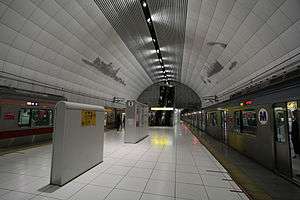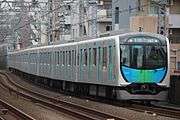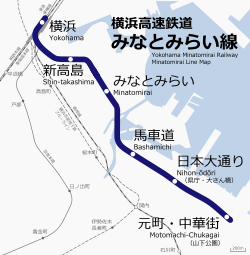Minatomirai Line
The Minatomirai 21 Line (みなとみらい21線 Minato-mirai-21-sen), commonly known as the Minatomirai Line (みなとみらい線 Minatomirai-sen), is a subway line of the Yokohama Minatomirai Railway Company connecting Yokohama Station to Yokohama Chinatown through the Minato Mirai 21 development.
On maps and station numbering the line is identified by the color navy blue and the route symbol MM. The line was opened on February 1, 2004. The whole line is underground and goes through the Yokohama Minato Mirai 21 and Kannai Districts. The line passes though numerous islands made of soft reclaimed land and channels requiring the stations to be built very deep. The original surface alignment Tokyu Toyoko line between Yokohama and Sakuragicho stations were abolished and replaced with a new underground alignment to connect and allow for through services with the newly completed Minatomirai Line.
| Minatomirai Line | |||
|---|---|---|---|
|
| |||
 Motomachi-Chukagai Station platform | |||
| Overview | |||
| Type | Rapid transit | ||
| Locale | Yokohama | ||
| Termini |
Yokohama Motomachi-Chūkagai | ||
| Stations | 6 | ||
| Operation | |||
| Opened | February 1, 2004 | ||
| Owner | Yokohama Minatomirai Railway Company | ||
| Operator(s) | Yokohama Minatomirai Railway Company, Tokyu Corporation | ||
| Rolling stock | Y500 series | ||
| Technical | |||
| Line length | 4.1 km (2.5 mi) | ||
| Track gauge | 1,067 mm (3 ft 6 in) | ||
| Electrification | 1,500 V DC, overhead catenary | ||
| |||
Operations
Through Services with the Tokyu Toyoko line
Almost all trains in the Minatomirai Line though operate with the Tokyu Toyoko line. Essentially the Minatomirai Line is an extension of the Toyoko line. Operationally the two lines operate as one with no crew change at Yokohama station when trains cross between the two companies in contrast to what is done with other through operating services in Japan.
Through services with Tokyo Metro Fukutoshin Line
With the completion of the underground link line to the Tokyo Metro Fukutoshin Line on March 16, 2013, Minatomirai Line trains run into the Fukutoshin Line via the Tokyu Toyoko line and beyond to the Tobu Tojo line, Seibu Yurakucho line, and Seibu Ikebukuro Line.
S-train
Limited express
Limited Express (特急 Tokkyū) trains run only during weekday daytime, Saturdays and on holidays during the early morning and late hours. Since March 26, 2016, trains that continuously and completely operate as express services through Tobu/Seibu, Tokyo Metro, Tokyu and Yokohama Minatomirai railways are dubbed as "F-Liner" services.
Commuter Express
Commuter Express (通勤特急 Tsūkin Tokkyū) operate at night and evening rush hour during the weekday. Many trains continue to the Fukutoshin line via the Toyoko Line as Commuter Express services.
Express
Express (急行 Kyūkō) operate all day. Many trains continue to the Fukutoshin line via the Toyoko Line as local services except in the morning rush hour.
Local
Local (各駅停車 Kakueki-teisha) trains stop at all stations.
Women only Car
In conjunction with the Tokyu Toyoko line, Tokyo Metro Fukutoshin Line, Seibu Ikebukuro Line, Tobu Tojo Line, the first car is a female-only car.
Stations
Key:
- O: stop; |: pass
| No. | Station name | Local | Express | Commuter Express | Limited Express | S-Train | Transfers |
|---|---|---|---|---|---|---|---|
| ↑ Through-running to/from TY Tokyu Toyoko Line, F Tokyo Metro Fukutoshin Line,TJ Tobu Tojo Line, and | |||||||
| Yokohama | O | O | O | O | O | ||
| Shin-Takashima | O | | | | | | | | | ||
| Minatomirai | O | O | O | O | O | ||
| Bashamichi | O | O | O | | | | | ||
| Nihon-ōdōri | O | O | O | | | | | ||
| Motomachi-Chūkagai | O | O | O | O | O | ||
Rolling stock
- Tokyu 5050 series 8-car EMUs
- Tokyu 5050-4000 series 10-car EMUs
- Y500 series 8-car EMUs
- Tokyo Metro 7000 series 8/10-car EMUs (since September 2012)
- Tokyo Metro 10000 series 8/10-car EMUs (since September 2012)
- Tobu 9000 series 10-car EMUs (since March 2013)
- Tobu 50070 series 10-car EMUs (since March 2013)
- Seibu 6000 series 10-car EMUs (since March 2013)
- Seibu 40000 series 10-car EMUs (since March 25, 2017)
- Tokyu 5050 series
 Tokyu 5050-4000 series
Tokyu 5050-4000 series Y500 series
Y500 series Tokyo Metro 7000 series
Tokyo Metro 7000 series- Tokyo Metro 10000 series
- Tobu 9000 series
- Tobu 50070 series
- Seibu 6000 series
 Seibu 40000 series
Seibu 40000 series
History
Construction of the line started in 1993, and the line was finally opened to the public on February 1, 2004.
8-car Tokyo Metro 10000 series sets entered revenue service on the Minatomirai Line and Tokyu Toyoko Line from September 7, 2012.[1]
See also
References
- ↑ 東京メトロ10000系が東横線・みなとみらい線で営業運転を開始 [Tokyo Metro 10000 series enters revenue service on Tokyu Toyoko and Minato Mirai Line]. Japan Railfan Magazine Online (in Japanese). Japan: Koyusha Co., Ltd. September 8, 2012. Retrieved September 11, 2012.
External links
- Minatomirai Line Official Website (in Japanese)
